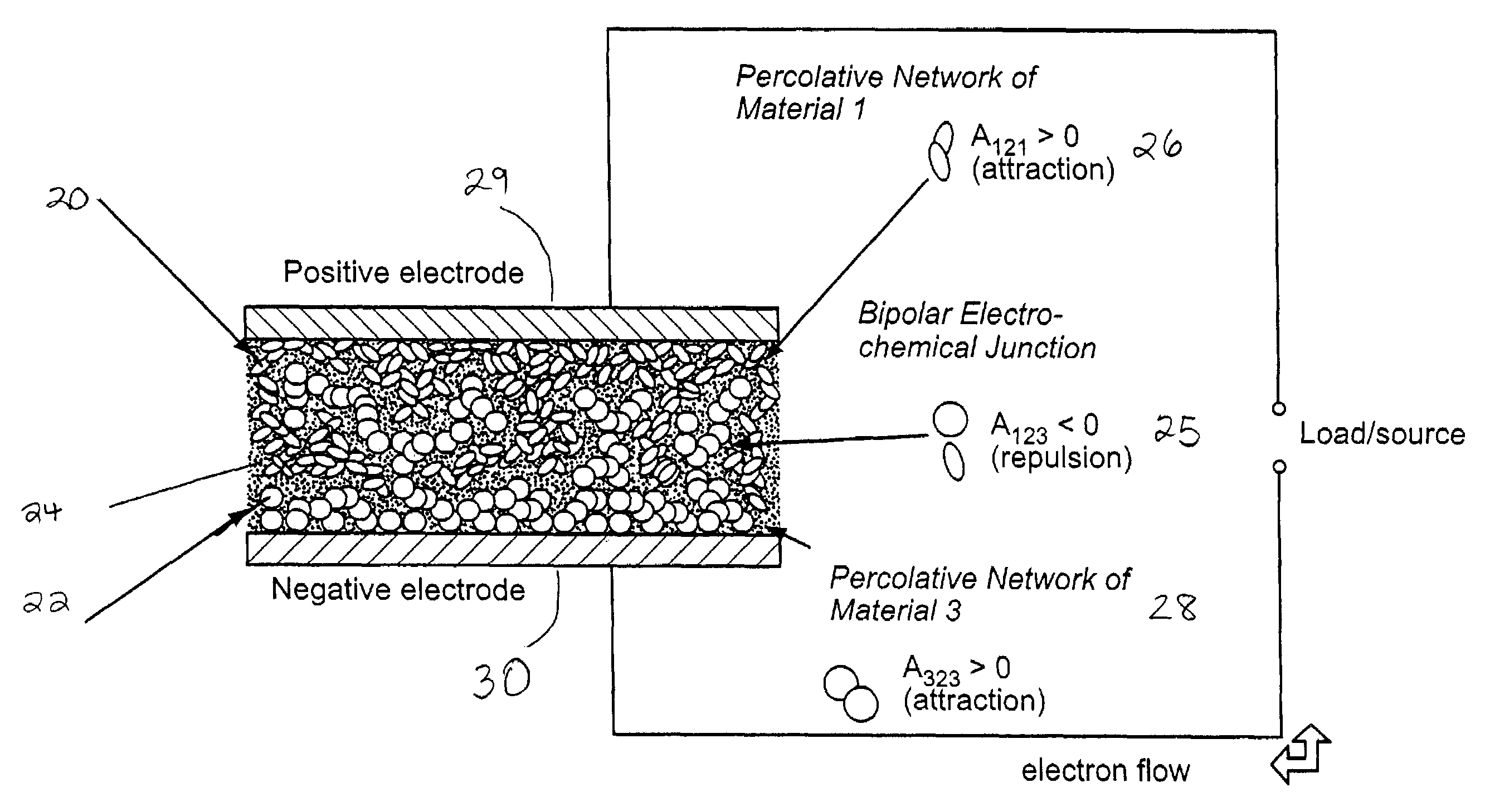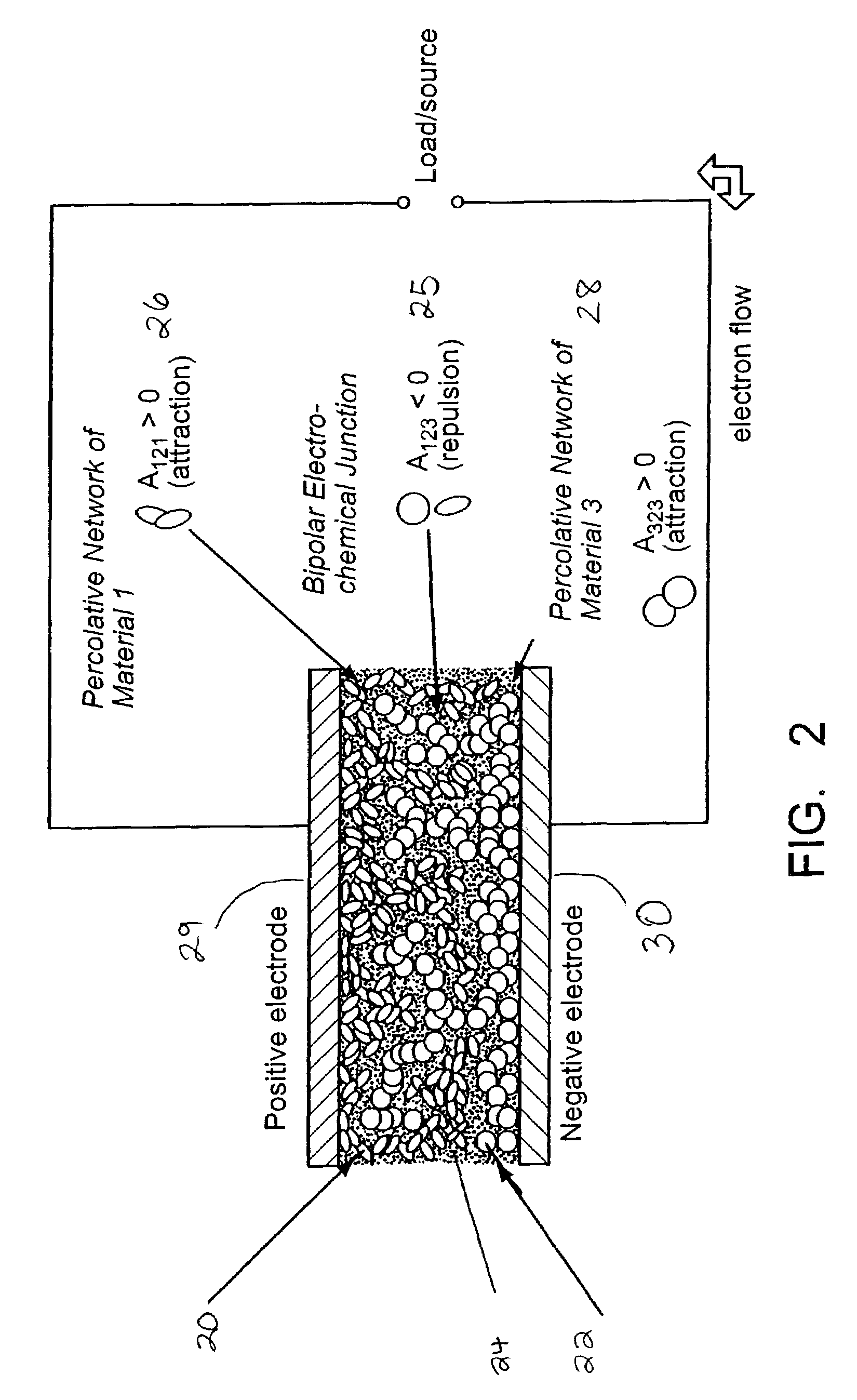Self-organizing battery structure with electrode particles that exert a repelling force on the opposite electrode
- Summary
- Abstract
- Description
- Claims
- Application Information
AI Technical Summary
Benefits of technology
Problems solved by technology
Method used
Image
Examples
example 1
Preparation of a Self-Organizing Battery Using a Crosslinked Polyethylene Glycol Dimethacrylate Solid Polymer Electrolyte
[0067]Polyethylene glycol dimethacrylate (PEG-DMA, molecular weight 770) was used as the crosslinkable polymer electrolyte precursor, into which 10 wt. % LiN(SO2CF3)2 salt was dissolved to instill Li ion conductivity, and 1 wt. % AIBN based on functional methacrylate was dissolved to act as initiator for the thermally induced crosslinking reaction. A mixing was conducted under glovebox conditions (Argon, 2, 2O.) Glassy carbon beads (sieved to 20 to 45 μm) were dispersed in the polymer / salt / initiator solution in the volume ratio 1:1 glassy carbon: PEG-DMA via mechanical stirring. A thin layer 500 of carbon / polymer / salt / initiator slurry was then cast onto a thin (5-10 μm) low refractive index conductive composite polymer film 502 on a substrate 510, as shown in FIG. 5. The conductive polymer film included a polytetrafluoroethylene (PTFE) latex acting as the low refr...
example 2
Preparation of a Self-Organizing Battery Using a Crosslinked Polyethylene Glycol Diacrylate Solid Polymer Electrolyte
[0068]Polyethylene glycol diacrylate (PEG-DA) was employed as the polymer electrolyte precursor (10 wt. % Li-TFMSI based on polymer electrolyte, 1 wt. % AIBN based on functional groups.) All other conditions were equivalent to those in Example 1. As shown in Table 1, of five samples produced, 2 exhibited a resistance between the conductive carbon / crosslinked polymer electrolyte composite and the underlying film of >1 MΩ, 2 had resistance between 100 kΩ and 1 MΩ, and 1 had a resistance <100 kΩ.
example 3
Preparation of a Self-Organizing Battery Using a Crosslinked Diacrylate / Methacrylate Blend
[0069]A blend of 80 wt. % methoxy(polyethylene glycol)methacrylate and 20 wt. % PEG-DA (80:20 MeOx-PEG-MA:PEG-DA) was employed as the polymer electrolyte precursor (10 wt. % Li-TFMSI based on polymer electrolyte, 1 wt. % AIBN based on functional groups.) All other conditions were equivalent to those in embodiment 1. As shown in Table 1, of five samples produced, all 5 exhibited a resistance between the conductive carbon / crosslinked polymer electrolyte composite and the underlying film of >1 MΩ.
[0070]
TABLE 1Summary of electrical isolation results between conductivecarbon / crosslinked polymer electrolyte composite and theunderlying conductive polymer film.Level ofPEG-DMAPEG-DMA80:20 MeOx-electricalrunrunPEG-PEG-DA:PEG-isolation12DADA1010100 kΩ− 1 MΩ2320>1 MΩ2225Total5555
PUM
 Login to View More
Login to View More Abstract
Description
Claims
Application Information
 Login to View More
Login to View More - R&D
- Intellectual Property
- Life Sciences
- Materials
- Tech Scout
- Unparalleled Data Quality
- Higher Quality Content
- 60% Fewer Hallucinations
Browse by: Latest US Patents, China's latest patents, Technical Efficacy Thesaurus, Application Domain, Technology Topic, Popular Technical Reports.
© 2025 PatSnap. All rights reserved.Legal|Privacy policy|Modern Slavery Act Transparency Statement|Sitemap|About US| Contact US: help@patsnap.com



